Every new advancement in AI within Hollywood elicits a mix of excitement and apprehension. Questions arise: How many jobs will be lost? How much work will be streamlined? Is this innovation a thoughtful response to the industry’s needs, or merely an excuse for producers to cut costs?
However, one thing is clear: Integration of AI is inevitable. What may not be fully recognized is that this shift began some time ago, and Hollywood seems to want to keep it under wraps for as long as possible.
Studios using AI. According to Vulture, about 100 studios in Hollywood are currently working exclusively with AI. Notably, one of them is Asteria Film, a studio co-founded by actress and producer Natasha Lyonne, known for her role in Poker Face. Additionally, Lyonne is set to direct the first film ever generated entirely by AI.
For now, studios emphasize their commitment to ethics by claiming that all material used to train their AI is licensed. Essentially, they’re developing tools that generate images based on prompts, while ensuring that they only use content for which they’ve obtained the necessary rights.
Creators. Hollywood is gradually embracing these technological tools. Notable directors like Darren Aronofsky have struck agreements with Google’s DeepMind, while James Cameron has partnered with Stability AI. The next challenge for Hollywood is to persuade the public and skeptics that AI can serve as a valuable tool for creators, not just the industry.
In an interview with Vulture, Lyonne said, “It’s more that I’m a filmmaker who doesn’t want the tech people deciding the future of the medium. We need some sort of Dogme 95 for the AI era.” Danish filmmaker Lars von Trier led the Dogme 95 movement in the 1990s, which aimed to strip cinema of unnecessary artifice.
Lyonne emphasizes her desire to “wrangle this artist-first idea before it becomes industry standard to not do it that way.” The potential clash between artists and studios may be enormous, but it’s evident that the industry is on the brink of changes that will shape the future of entertainment.
How much money are studios saving? This is one of the most important questions in Hollywood because it ultimately concerns production and expense management. According to industry experts, Hollywood could save between 20% and 50% on traditional productions. Additionally, it could potentially save up to 90% on projects that heavily rely on AI, especially in visual effects.
The estimated potential savings for the U.S. film and TV industry are around $15 billion between 2024 and 2026, focusing solely on production and post-production costs. Cameron himself said that blockbuster budgets could see a 50% reduction.
The beginnings of AI. Over the last decade, AI has increasingly been used as a tool to assist in specific aspects of production. This includes optimizing shooting schedules, resource allocation, and equipment management. By improving efficiency and reducing downtime, AI has proven valuable.
In the editing department, studios are using it to automatically select shots and perform simple but labor-intensive tasks like synchronizing audio and video.
Pre-production. In the past five years, the use of AI has surged, particularly in technical areas across all production phases. For instance, in pre-production, a variety of tools assist or directly replace human efforts.
LTX Studio can carry out complete pre-production by integrating diverse tools on a single platform. Specialized AIs like Filmustage help with film planning. Meanwhile, Boords creates storyboards, and Largo.ai analyzes potential film impacts, facilitating production tasks.
Filming. This phase incorporates familiar elements such as camera and drone control, smart lighting, and virtual sets. Tools like Stagecraft generate real-time environments that integrate physical actors and digital backgrounds, often projecting these scenarios and their modifications so that performers can react accordingly.
This is where many groundbreaking changes are occurring, capturing all media attention, but it represents just the tip of the iceberg.
Post-production. In post-production, AI is progressively replacing routine and repetitive tasks. Tools such as DeepMotion and Ziva Dynamics are making waves in the effects and animation fields. Additionally, AI assists with audio and video synchronization and color correction through tools like Colourlab Ai.
While AI dubbing is still in its early stages, advancements like DeepDub, which offers near-imperceptible lip-syncing, are evolving, although with some controversy. Moreover, platforms like Amper Music are providing soundtracks for modest-budget productions.
Legal issues. Many believe that most strikes in Hollywood were initiated to combat practices that threaten the work of creators and jobs. This was particularly evident during the major labor crisis between 2023 and 2024, largely driven by the rise of AI. The main unions–the Writers Guild of America (WGA) for screenwriters and SAG-AFTRA for actors–were in conflict with the Alliance of Motion Picture and Television Producers. The WGA went on strike in May 2023, and actors joined in July, resulting in a six-month shutdown of Hollywood.
The agreement reached during this crisis significantly limited the use of AI. It prohibits production companies from using generative AI to create scripts without a screenwriter’s involvement or to replicate an actor’s likeness without their permission.
However, AI can still be used as a tool to assist technicians, as long as a unionized human is involved in the process. In a highly litigious environment, production companies are keen to avoid costly legal battles over AI use that could delay the release of major films.
The future remains uncertain. Hollywood is mindful of the negative public perception of AI tools, which prompts a cautious approach. Numerous studios are starting to experiment with AI and the potential for significant cost savings. However, the pressing question isn’t whether AI will penetrate the industry, but rather when–likely sometime in 2026 or 2027.
Image | Jake Blucker
Related | Lilo & Stitch Has Made Live-Action Films Successful Again. It Won’t Be That Easy for the Next One




View 0 comments